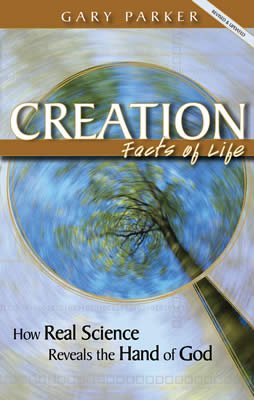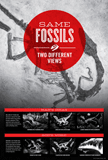
3.1 The Fossil Evidence—Introduction
After I spoke on creation to a packed auditorium of students and professors at a Tennessee University, one of the professors accused me of misrepresenting evolution when I called it a progressive change from a few simple life forms to many complex and varied ones. He explained that there is nothing inherent in the process of mutation-selection that promotes either complexity or progress. Mutations occur at random in no particular direction, and selection merely rewards and propagates the most reproductively successful exploiters of environmental resources in each generation.
I had to admit that he was right about the presumed evolutionary mechanism of mutation-selection (TCSD). Then I asked if he, as an evolutionist, believed that there was a time in the earth’s past when the most complex forms of life were bacteria. He said, “Yes, of course.” Then I asked if he believed there was a later time when life on earth included bacteria but also a wide variety of invertebrates (clams, snails, worms, etc.), but no vertebrates. Even though he now knew where I was going, as an evolutionist he still had to say, “Yes.” He had to agree that later still the earth included a wide variety of vertebrates (fish, dinosaurs, people) in addition to invertebrates and bacteria. So, I concluded for him, earth’s history involved a progression from a few simple life forms to many complex ones. But, as he himself had stated in challenging me, there is nothing about mutation-selection (time, chance, struggle, and death) which explains that kind of progression. Mutation-selection (TCSD), yes; evolution, no.
Much of the public accepted that evolution had occurred in the past because they were taught to see mutation-selection at work in the present. Nobody (except creationists) told them that professional scientists in the second half of the 20th century seriously challenged or even abandoned mutation-selection as a mechanism for molecules-to-man evolution. Discoveries in computer-assisted math, cell ultrastructure, DNA, and molecular biology during the 1950s, 60s, and 70s forced a “revolution in evolution” when the world’s leading experts on evolution met in Chicago in 1980. As summarized professionally by Lewin in Science1 (and popularly by Adler and Carey in Newsweek2),
The central question of the Chicago conference was whether the mechanisms underlying microevolution [mutation-selection] could be extrapolated to explain the phenomena of macroevolution.
That’s the central question considered in the last chapter: Can changes from molecules-to-man (macroevolution) be explained by (extrapolated from) the process of mutation-selection (microevolution)? You know my answer; how did the world’s leading evolutionists answer that question?
At the risk of doing violence to the positions of some of the people at the meetings, the answer can be given as a clear, No (emphasis added).
Just plain NO. Experts from around the world looking at supposed evidences for evolution in their own scientific disciplines reached the same conclusion for the same reasons creationists had already cited. You just can’t get from microevolution (mutation-selection) to macroevolution (molecules-to-man), no matter what the time involved, just like you can’t get to the moon by riding a bicycle. There are just too many logical and scientific limits to such an extrapolation.
You would think that this major revolution in evolution would have stimulated vibrant national dialogue, numerous talk show appearances, and changes in the world of education. But textbooks, television programs, and museum displays chose to ignore these advances in science, just as they have chosen to ignore advances in molecular machinery, DNA coding, and information theory that have heaped more challenges onto evolutionary theory since 1980.
Indeed, textbooks, television programs, and museum displays in the early 21st century continue to present the arguments for evolution used in the late 19th and early 20th centuries! Now you can see why the professor at the Tennessee University was so frustrated; I was criticizing evolutionist arguments that professional evolutionists had already discarded. Perhaps you can also see why I was frustrated; I still had to debunk those falsified evolutionist ideas because they were still being palmed off on the public by the new “edutainment” industry producing textbooks, television programs, museum displays, and other “docudramas” in which marketing a message is much more important than mere scientific facts and the pursuit of truth.
Why don’t more scientists speak out against such an abuse of science? One answer: fossils.
Many scientists admit they have no evidence of, nor use for, evolution in their own specialized branches of science, but there’s a “widespread feeling” among scientists and the general public that fossils somehow “prove evolution” anyway. “Maybe mutation-selection doesn’t explain how evolution occurred,” a knowledgeable evolutionist might say, “but fossils prove that evolution did occur. The evidence for millions of years of struggle and death is right under our feet as fossils—billions of dead things, buried in rock layers, laid down by water, all over the earth!”
The showcase for evolution is, of course, the Grand Canyon. As a professor enthusiastically pushing evolution, I used to think “If only these Christian students would take a trip to the Grand Canyon, they would see the evidence for evolution laid out right before their very eyes. If they could just look at those rock layers a mile deep, full of fossils showing the stages of evolution, maybe they’d just throw their Bibles over the edge, and try to get in touch with a ‘god’ more in sync with modern science.”
Now I’ve ruined everything! If only I hadn’t mentioned fossils, maybe I could have convinced you that the evidence we’ve looked at (biochemistry, embryology, homology, ecology, genetics, adaptation, classification, variation) really supports plan, purpose, and special acts of creation, not time, chance, struggle, and death, but if we’re going to honestly “think about it,” we’ve got to include fossils.
Fossils used to scare me. After my heart and mind were opened to consider the 4C biblical outline for origins in contrast to evolution, I gradually convinced myself (over a three-year period!) that the evidence in biology overwhelmingly favored the biblical view, but friends knew how to stop me cold: “Look, Parker, if you only knew anything about fossils (paleontology), then you’d give up this creationist nonsense and come on back into the scientific age with the rest of us!” I even began to wonder whether some parts of the Bible and evolution could still be made to fit together—“progressive creation” maybe?
About that time, God did something wonderful for me. I won a grant from the National Science Foundation for 15 months of full-time work on my doctoral degree. To my major in biology, I added a minor in geology, emphasizing the study of fossils and origins. I had done my master’s degree work as a practicing atheist and evolutionist. Now, I was sure I was a Christian, and I leaned toward creation, but if the fossils didn’t work out, I just wouldn’t talk about creation any more.
Well, I fell in love with fossils. My family and I (that’s two rock hounds and four pebble pups!) have collected oodles of fossils from numerous sites in America, Canada, and Australia, and a few spots in Europe, South America, and Asia, and I regularly lead university students in field-study courses to the Grand Canyon and to well-known fossil sites.
Fossils are the remains or traces of once-living things preserved largely in sedimentary deposits. They represent the closest we can come to historical evidence in this matter of origins, so they are of prime importance in comparing biblical and evolutionary pictures of history. Actually, fossils can help us with two types of questions: First, what kinds of plants and animals once populated the earth? Second, how fast were fossils, and the rock layers that contain them, formed?
Creation: Facts of Life
Dr. Parker, a leading creation scientist and former AiG speaker, presents the classic arguments for evolution used in public schools, universities, and the media, and refutes them in an entertaining and easy-to-read style. A must for students and teachers alike! This is a great book to give to a non-Christian as a witnessing tool.
Read OnlineFootnotes
- Roger Lewin, “Evolutionary Theory Under Fire,” Science (November 21, 1980).
- Jerry Adler and John Carey, “Is Man a Subtle Accident?” Newsweek (November 3, 1980).
Recommended Resources

Answers in Genesis is an apologetics ministry, dedicated to helping Christians defend their faith and proclaim the good news of Jesus Christ.
- Customer Service 800.778.3390
- © 2024 Answers in Genesis




